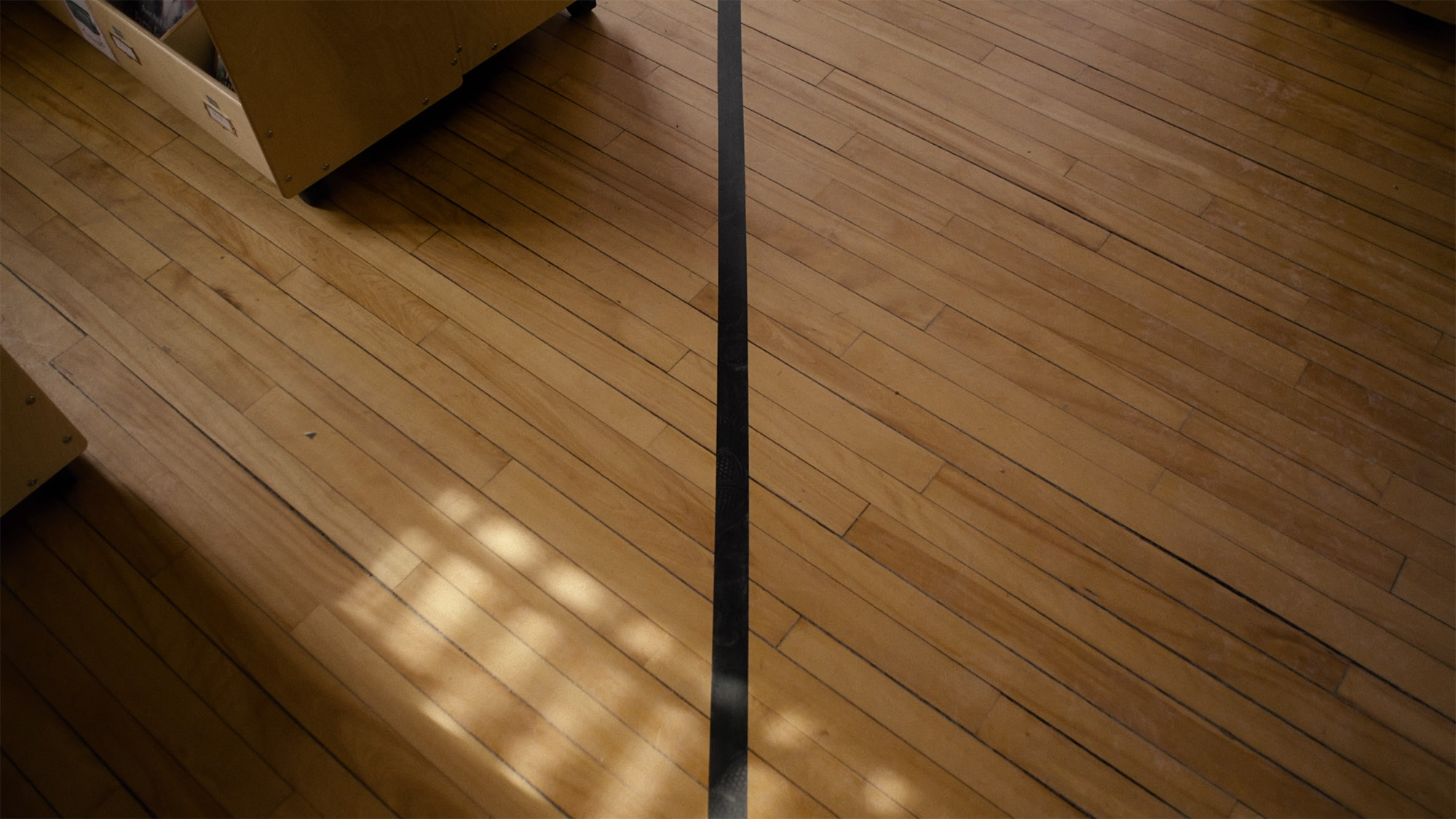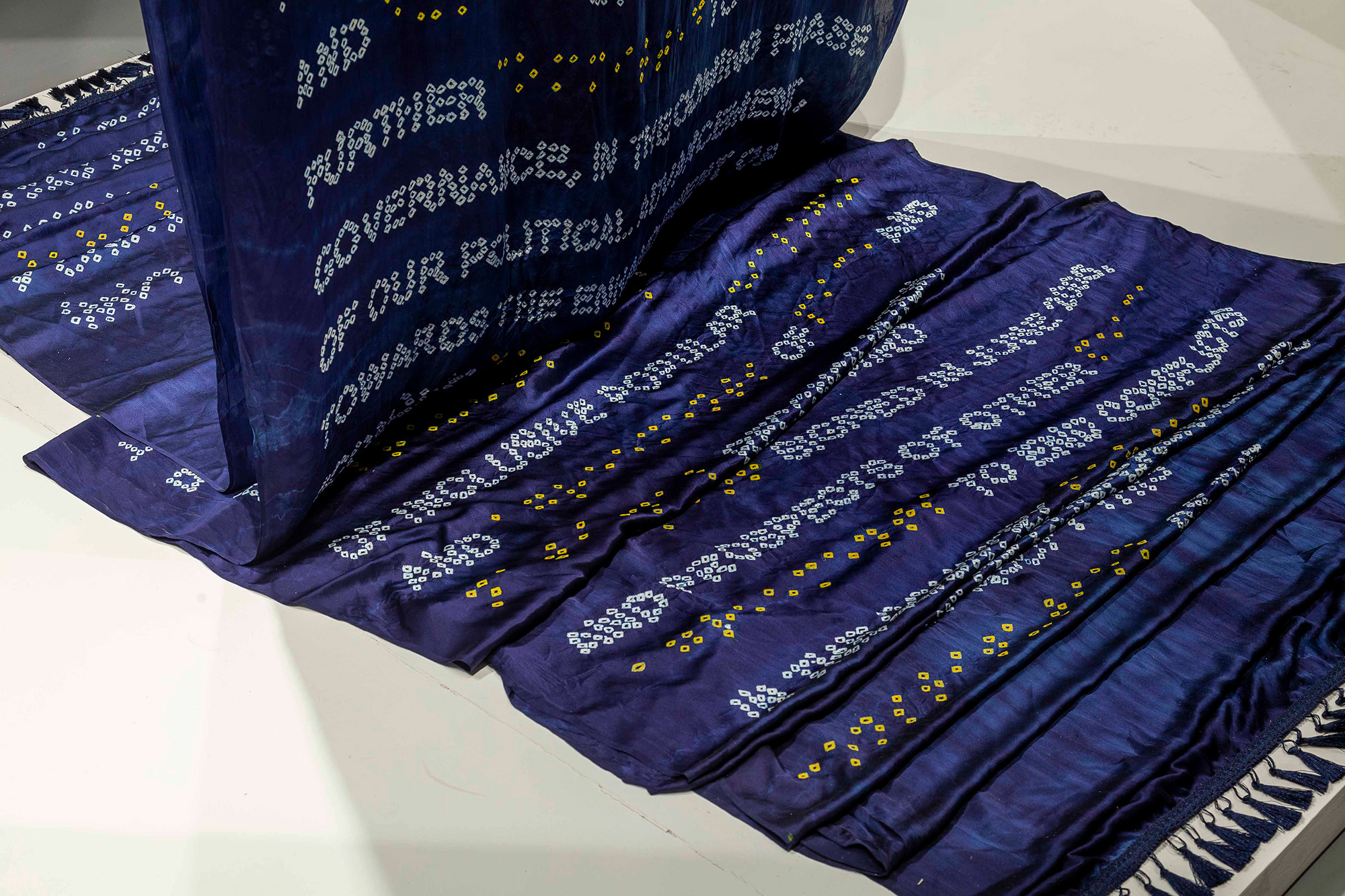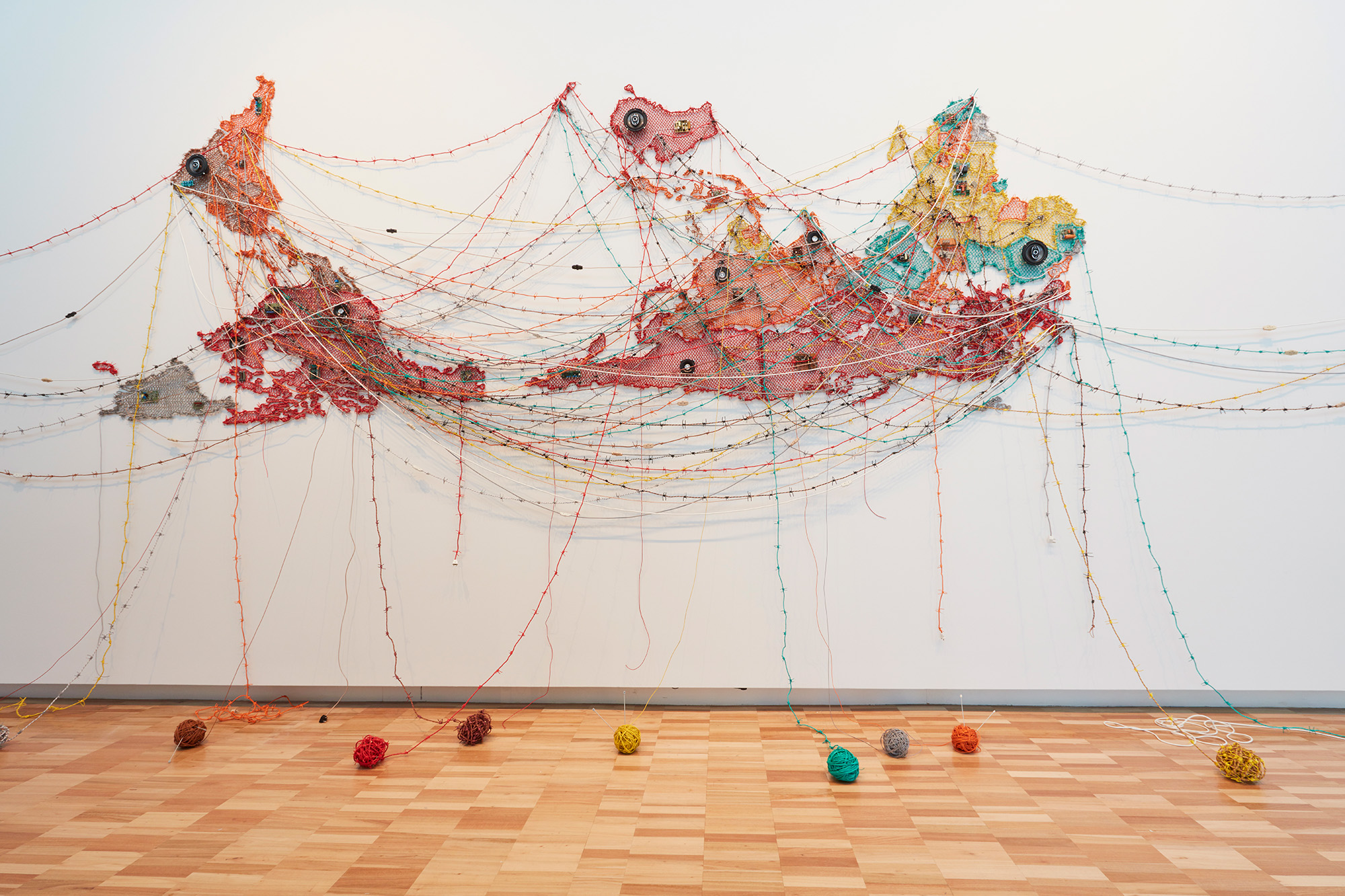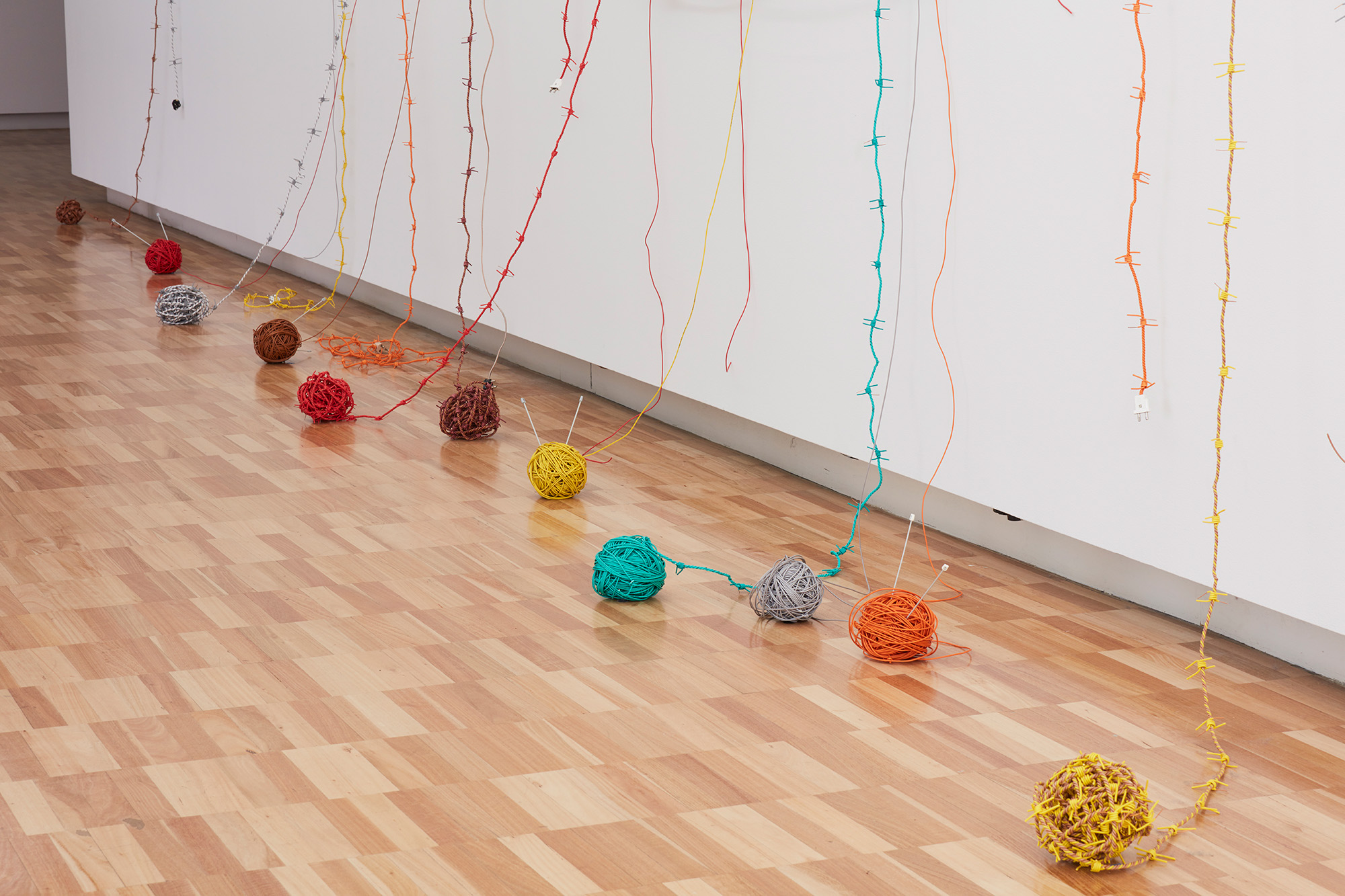Artists crossing borders: Lawrence Abu Hamdan & Reena Saini Kallat
Two exhibitions see artists crossing national borders, exploring both the violence & absurdity of geometric constructs laid across landscape & sometimes through architectures. At Spike Island, Lawrence Abu Hamdan muses on the unique Haskell Free Library & Opera House sitting in both the USA & Canada, while at Compton Verney Reena Saini Kallat explores national borders across the globe, finding ways nature & people have crossed over.
“The Haskell Free Library is a 400 square metre anomaly. A
granite and brick loophole in the longest land border in the world,” the
narrator of Lawrance Abu Hamdan’s new film 45th Parallel tells us. It is a building which can
be entered – and exited – from both Canada and the USA.
There are no passport checks to get in or out, but a US Border Guard sits in a nearby car watching who goes in and who comes out. They watch to make sure that those who enter from the Canada side of the street return to the same side, and that booklovers from the US side similarly leave the library and head back to the US side of the street.
![]()
![]()
![]()
The border line runs through the library, with the camera of Hamdan’s cinematographer Jarred Alterman floating around the architecture, also capturing the thick black line painted through the spaces to demark the division. But the film also remarks on the absurdity of this line bisecting the building: “Agatha Christie sits on a shelf on US soil, while Iggy Pop’s biography is in Canada.”
Narrator Mahdi Fleifel tells us that the library was once used to move pistols illegally between the two countries, the individuals moving the firearms did not move between nation states, but the pistols did: “Not one of them left their home country, and yet the pistols crossed the border.”
![]()
![]()
![]()
Attached to the library is the town’s opera house, and the same black line cuts through and under the seats, disregarding the symmetry of the space. The library and opera house building appears to celebrate that cliché that learning and culture somehow permeates boundaries, that literature and creativity can heal human divisions, but this is tested when Hamden overlays into the physical space of the opera house a story of boys playing on the Mexico-US border - where the division is less relaxed.
As the camera lingers in the safe-space of Haskell, the words reveal what happened further south as a US border guard shot across the Mexican border, killing a child the other side. On the opera house stage Hamden has recreated the Mexico border architecture and landscape, and suddenly this poetic building is a space of three nations working to two entirely different inter-nation relationships.
The Spike Island presentation of the film takes place amid a number of other Hamdan canvases, hung like backdrops from the opera house’s productions, adding another level of narration to the border stories compressed into the narrated film. As the short film progresses, the story travels further away. US drone operators from the US who killed hundreds of innocents in Afghanistan, Yemen, and Pakistan also question the legality and logic of how the military-industrial complex can ignore statehood as freely as a booklover in Haskell.
![]()
![]()
![]()
At Compton Verney – a house set within a Capability Brown landscape, not only visited for its setting and Grade I listed architecture, but also an ongoing series of art exhibitions within a Stanton Williams designed wing – Indian artist Reena Saini Kallat similarly questions the arbitrary geometry of national borders with her exhibition Common Grounds. With a practice which is widely mixed-media, with this installation including installation, wall-sculptures made of electric cabling, sound works, silks, collage, and photography.
Where Hamdan imbues guns and weaponry as having the power to transgress statehood boundaries and seemingly freely cross territories at well (when a government wishes), Kallat puts the same agency into nature. Birds embody a similar freedom to the pistols and drones in the film at Spike Island, but here that testing of border is celebratory, and leads to conversations about reaching beyond human structures, not compounding or ignoring them for political desire.
![]()
![]()
![]()
Figs.x-xii
The ten hanging dyed silks of Verso-Recto-Recto-Verso (2017-19) focuses on various nervous division lines: USA to Cuba, India to Pakistan, North to South Korea, China to Japan, and South Sudan to the Republic of Sudan. Each silk has written upon it the preamble to that country’s constitution, backs up against the nation they have conflict with. It is noticeable how these texts differ in length, suggesting an imbalance of human and civic rights afforded to different places, but also the artist has removed certain words and replaced them with braille dots – words that within a gallery context where artworks should never be touched, cannot be read. These constitutions have been interrupted – just as Hamdan observed military laws interrupted to suit conflict desires – representing a collective amnesia to the original function of the texts, questioning both the faces of national representation but also the delicate space of differences between.
![]()
![]()
![]()
It is an exploration of all that finds ways across division, and in another work Kallat considers rivers – so often the very marker of the pink-dotted lines which follow and use their watercourse as a spacer between nations, but also fundamental forces of nature which shift and move over time.
A new work, Vortex (2022), uses more electrical cabling to map rivers which sit between countries which are in dispute despite sharing the watery boundary. Together, they read as a thumbprint, while smaller works making up Leaking Lines (2019-20) alongside interrogate each river in a macro scale, framed montages combining gouache, wire, and text. When rivers can be dammed to enact physical control, as clean water is an increasingly useful tool of power, and as a symbol of man’s attempted control not only over each other but the shared natural infrastructure which binds us together, these frames form tiny reliquaries to forces of nature which are at once so forceful yet so precarious.
![]()
Together, these two exhibitions explore borders for all their strength and absurdity. For what is an entirely man-made construct (as the black line running through the Haskell library and opera house so viscerally notates) these lines are the bedrock of politics, power, military, and law. Yet, as both artists show, they are also entirely permeable, their abstract nature foiled whether by nature, criminal, in-need migrant, or neoliberal desire. These are systems laid upon nature – and through architectures – which we chose to exist, and which only remain in existence due to a consensual hallucination. But both Kallat and Hamdan shed light across their arbitrariness, inviting questions as to how they are actuated in everyday life, and inviting questions over whether they should be.
For all the barbed wire, guns, and separation, both also leave on a note of togetherness in disregard for forced division. As Kallat’s birds sharing song and observations of human connection continue despite the political and physical barriers, so to is Haskell library used as a space of sharing – it is now a safe space for friends and relatives from Yemen, Syria, Iran, Sudan, Iraq, Somalia, and Libya who are only legally allowed in either Canada or the USA to come together to see one another without having to cross any borders.
There are no passport checks to get in or out, but a US Border Guard sits in a nearby car watching who goes in and who comes out. They watch to make sure that those who enter from the Canada side of the street return to the same side, and that booklovers from the US side similarly leave the library and head back to the US side of the street.



Figs.i-iii
The border line runs through the library, with the camera of Hamdan’s cinematographer Jarred Alterman floating around the architecture, also capturing the thick black line painted through the spaces to demark the division. But the film also remarks on the absurdity of this line bisecting the building: “Agatha Christie sits on a shelf on US soil, while Iggy Pop’s biography is in Canada.”
Narrator Mahdi Fleifel tells us that the library was once used to move pistols illegally between the two countries, the individuals moving the firearms did not move between nation states, but the pistols did: “Not one of them left their home country, and yet the pistols crossed the border.”



Figs.iv-vi
Attached to the library is the town’s opera house, and the same black line cuts through and under the seats, disregarding the symmetry of the space. The library and opera house building appears to celebrate that cliché that learning and culture somehow permeates boundaries, that literature and creativity can heal human divisions, but this is tested when Hamden overlays into the physical space of the opera house a story of boys playing on the Mexico-US border - where the division is less relaxed.
As the camera lingers in the safe-space of Haskell, the words reveal what happened further south as a US border guard shot across the Mexican border, killing a child the other side. On the opera house stage Hamden has recreated the Mexico border architecture and landscape, and suddenly this poetic building is a space of three nations working to two entirely different inter-nation relationships.
The Spike Island presentation of the film takes place amid a number of other Hamdan canvases, hung like backdrops from the opera house’s productions, adding another level of narration to the border stories compressed into the narrated film. As the short film progresses, the story travels further away. US drone operators from the US who killed hundreds of innocents in Afghanistan, Yemen, and Pakistan also question the legality and logic of how the military-industrial complex can ignore statehood as freely as a booklover in Haskell.



Figs.vii-ix
At Compton Verney – a house set within a Capability Brown landscape, not only visited for its setting and Grade I listed architecture, but also an ongoing series of art exhibitions within a Stanton Williams designed wing – Indian artist Reena Saini Kallat similarly questions the arbitrary geometry of national borders with her exhibition Common Grounds. With a practice which is widely mixed-media, with this installation including installation, wall-sculptures made of electric cabling, sound works, silks, collage, and photography.
Where Hamdan imbues guns and weaponry as having the power to transgress statehood boundaries and seemingly freely cross territories at well (when a government wishes), Kallat puts the same agency into nature. Birds embody a similar freedom to the pistols and drones in the film at Spike Island, but here that testing of border is celebratory, and leads to conversations about reaching beyond human structures, not compounding or ignoring them for political desire.



Figs.x-xii
In her playful sculpture Chorus I (2015-19) an absurd
twisted version of WWII pre-radar listening devices play the delicate sounds of
birdsong to a visitor stood at their earpieces. The birdsong of national birds
of cross-border nations sing together – The Israeli hoopoe and Palestinian
sunbird aurally dance, the crested caracara of Mexico duets with the eagle of
the USA. It’s a light, carefree game, but one which resonates coming from an
artist whose family experienced the violent imposition of the India-Pakistan
1947 partition and its impact since.
The ten hanging dyed silks of Verso-Recto-Recto-Verso (2017-19) focuses on various nervous division lines: USA to Cuba, India to Pakistan, North to South Korea, China to Japan, and South Sudan to the Republic of Sudan. Each silk has written upon it the preamble to that country’s constitution, backs up against the nation they have conflict with. It is noticeable how these texts differ in length, suggesting an imbalance of human and civic rights afforded to different places, but also the artist has removed certain words and replaced them with braille dots – words that within a gallery context where artworks should never be touched, cannot be read. These constitutions have been interrupted – just as Hamdan observed military laws interrupted to suit conflict desires – representing a collective amnesia to the original function of the texts, questioning both the faces of national representation but also the delicate space of differences between.



Figs.xiii-xvi
Other works also navigate border lines through other
mediational devices. Wire recurs, both in its barbed form and also as electrical
cabling. Woven Chronicle (2018) is a large wall installation in which
both types of wire are used to create an upside-down map of the world,
migratory routes seemingly compressing the lands beneath into submission,
reminding that yes there are flows across and around the world, but only those
of invitation or desperation.
It is an exploration of all that finds ways across division, and in another work Kallat considers rivers – so often the very marker of the pink-dotted lines which follow and use their watercourse as a spacer between nations, but also fundamental forces of nature which shift and move over time.
A new work, Vortex (2022), uses more electrical cabling to map rivers which sit between countries which are in dispute despite sharing the watery boundary. Together, they read as a thumbprint, while smaller works making up Leaking Lines (2019-20) alongside interrogate each river in a macro scale, framed montages combining gouache, wire, and text. When rivers can be dammed to enact physical control, as clean water is an increasingly useful tool of power, and as a symbol of man’s attempted control not only over each other but the shared natural infrastructure which binds us together, these frames form tiny reliquaries to forces of nature which are at once so forceful yet so precarious.

Fig.xvii
Together, these two exhibitions explore borders for all their strength and absurdity. For what is an entirely man-made construct (as the black line running through the Haskell library and opera house so viscerally notates) these lines are the bedrock of politics, power, military, and law. Yet, as both artists show, they are also entirely permeable, their abstract nature foiled whether by nature, criminal, in-need migrant, or neoliberal desire. These are systems laid upon nature – and through architectures – which we chose to exist, and which only remain in existence due to a consensual hallucination. But both Kallat and Hamdan shed light across their arbitrariness, inviting questions as to how they are actuated in everyday life, and inviting questions over whether they should be.
For all the barbed wire, guns, and separation, both also leave on a note of togetherness in disregard for forced division. As Kallat’s birds sharing song and observations of human connection continue despite the political and physical barriers, so to is Haskell library used as a space of sharing – it is now a safe space for friends and relatives from Yemen, Syria, Iran, Sudan, Iraq, Somalia, and Libya who are only legally allowed in either Canada or the USA to come together to see one another without having to cross any borders.
Lawrence Abu Hamdan’s (b. 1985, Amman, Jordan) audio investigations have been used as evidence at the Asylum and Immigration Tribunal in the UK and as advocacy for organisations such as Amnesty International. He has exhibited at the 58th Venice Biennale (2019); the 13th and 14th Sharjah Biennial (2017 and 2019); the 11th Gwangju Biennale (2016) and Tate Modern. As part of a temporary collective with nominated artists Helen Cammock, Oscar Murillo and Tai Shani, he was awarded the 2019 Turner Prize.
www.lawrenceabuhamdan.com
Reena Saini Kallat (b. 1973, Delhi, India) lives and works in Mumbai. Her work is widely exhibited at institutions including the Museum of Modern Art (MOMA), New York; Migros Museum of Contemporary Art, Zurich; Museum of Modern and Contemporary Art, Seoul; SITE SantaFe, New Mexico; Mori Art Museum, Tokyo; Arken Museum of Modern Art, Denmark; Helsinki City Art Museum, Finland amongst many others. Her solo exhibitions at Museums include the Norrtalje Konsthall, Sweden (2021); National Museum of Asian Arts - Guimet, Paris (2020); the Manchester Museum (2017); Offsite, Vancouver Art Gallery (2015); Bhau Daji Lad Museum, Mumbai (2013); Kennedy Centre, Washington (2011).
www.reenakallat.com
Spike Island supports, produces and presents contemporary art and culture across an 80,000 square foot former industrial building in Bristol. Its diverse artistic programme includes free major exhibitions, events and engagement activities taking place on-site and online. Championing outstanding work by emerging and underrepresented local, national and international artists, the programme enhances access to contemporary art for audiences from all backgrounds.
www.spikeisland.org.uk
www.reenakallat.com
Spike Island supports, produces and presents contemporary art and culture across an 80,000 square foot former industrial building in Bristol. Its diverse artistic programme includes free major exhibitions, events and engagement activities taking place on-site and online. Championing outstanding work by emerging and underrepresented local, national and international artists, the programme enhances access to contemporary art for audiences from all backgrounds.
www.spikeisland.org.uk
Compton Verney is
an extraordinary place, a cultural kaleidoscope. We invite you to roam and
discover, be yourself, lose yourself and find yourself. Your search for truth
and beauty will bring food for thought and a feast for the soul, leaving you
feeling uplifted. It is
an award-winning gallery, based in a Grade I-listed Georgian mansion amidst 120 acres of Grade II-listed Lancelot 'Capability' Brown parkland in
Warwickshire. With six permanent collections (Naples, Northern European Art
1450-1650, British Portraits, Chinese, British Folk Art & The Marx-Lambert
Collection) and a schedule of
thought-provoking changing exhibitions and events both outdoors and in. It is an
accredited museum, and a registered charity.
www.comptonverney.org.uk
Compton Verney is
an extraordinary place, a cultural kaleidoscope. We invite you to roam and
discover, be yourself, lose yourself and find yourself. Your search for truth
and beauty will bring food for thought and a feast for the soul, leaving you
feeling uplifted. It is
an award-winning gallery, based in a Grade I-listed Georgian mansion amidst 120 acres of Grade II-listed Lancelot 'Capability' Brown parkland in
Warwickshire. With six permanent collections (Naples, Northern European Art
1450-1650, British Portraits, Chinese, British Folk Art & The Marx-Lambert
Collection) and a schedule of
thought-provoking changing exhibitions and events both outdoors and in. It is an
accredited museum, and a registered charity.
www.comptonverney.org.uk
visit
45th Parallel by Lawrence Abu Hamdan is on at Spike Island, Bristol, until 29 January 2023. More information at:
www.spikeisland.org.uk/programme/exhibitions/lawrence-abu-hamdan
Common Grounds by Reena Saini Kallat is on at Compton Verney until 22 January 2023. More information at:
www.comptonverney.org.uk/event/reena-kallat-common-grounds
images
figs.i-vi Lawrence Abu Hamdan, 45th Parallel (2022). Film Still. Courtesy the artist. Commissioned by Spike Island, Bristol; Mercer Union, Toronto; the Toronto Biennial of Art; and the Western Front, Vancouver.
figs.vi-ix
Lawrence Abu Hamdan, 45th Parallel (2022). Installation view, Spike Island. Courtesy the artist, photograph by Dan Weill
figs.x,xii Reena Kallat, Verso-Recto-Recto-Verso, 2017-19. Photograph courtesy Compton Verney & the artist.
figs.xii Reena Kallat, Chorus I, 2015-2019.
Photograph courtesy Compton Verney & the artist.
figs.xiii-xvi Reena Kallat, Woven Chronicle, 2018.
Photograph courtesy Compton Verney & the artist.
fig.xvii Reena Kallat, Leaking Lines (Tagus River), 2019-2020.
Photograph courtesy Compton Verney & the artist.
publication date
05 December 2022
tags
Lawrence Abu Hamdan, Jarred Alterman. Birds, Border, Boundary, Cable, Canada, Collage, Compton Verney, Division, Drone, Film, Mahdi Fleifel, Guns, Haskell Free Library, India, Israel, River, Reena Saini Kallat, Mexico, Military, Opera House, Palestine, Pakistan, Spike Island, USA, Wire
www.spikeisland.org.uk/programme/exhibitions/lawrence-abu-hamdan
Common Grounds by Reena Saini Kallat is on at Compton Verney until 22 January 2023. More information at:
www.comptonverney.org.uk/event/reena-kallat-common-grounds


